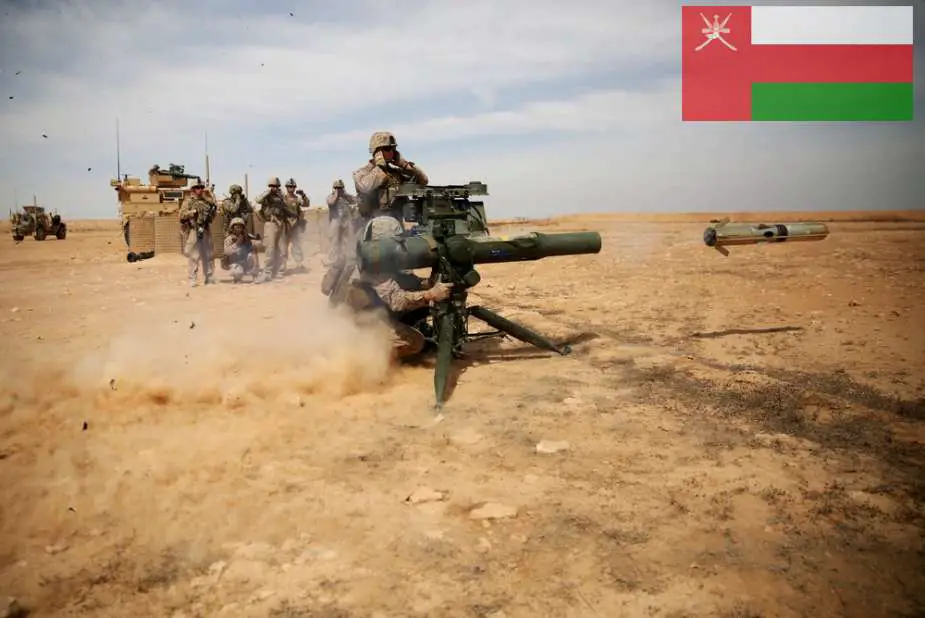Breaking news
Oman secures $70 Mn TOW 2B RF antitank missiles deal with US.
On October 3, 2023, the US State Department granted approval for a potential Foreign Military Sale (FMS) to the Government of Oman, involving the acquisition of 301 Tube-Launched, Optically-Tracked, Wireless-Guided (TOW) 2B Radio Frequency (RF) missiles (BGM-71F-7-RF), at an estimated cost of $70 million. Alongside these missiles, which include seven "Fly-to-Buy" missiles, the sale also encompasses technical, program, logistics, and engineering support services from both the US Government and contractor sources, as well as various logistics and program support elements.
Follow Army Recognition on Google News at this link

US Marine firing a BGM-71 TOW, similar to the one acquired by Oman, during an exercise in Iraq in 2015 (Picture source: US DoD)
The TOW 2B Radio Frequency Missile is part of the TOW missile system, a longstanding heavy anti-tank missile weapon system developed by Raytheon. With over 40 armed forces worldwide employing this system, it serves various roles, including anti-armor, anti-bunker, anti-fortification, and anti-amphibious landing functions. The TOW system boasts integration on more than 15,000 ground, vehicle, and helicopter platforms around the globe, and it underwent wireless guidance enhancements in 2010, making it a valuable asset to the U.S. Army, Marines, and other users.
Raytheon Systems Company introduced the TOW EagleFire launcher in October 2015, which is capable of firing both wire-guided and wireless radio frequency missiles. This next-generation launcher brings improved target acquisition and engagement capabilities to the system, powered by lithium-ion technology, enabling silent operation for up to nine hours, among other structural and technological advancements.
The TOW missile system has been in service since 1970 and has seen extensive use, with over 700,000 TOW weapon systems delivered to date. Its production versions include TOW 2A (BGM-71E) and TOW 2B (BGM-71F), which complement each other along with variants like TOW 2B Aero and TOW 2A bunker buster (BGM-71H). The TOW 2B missile system made its operational debut during Operation Iraqi Freedom.
The missiles can be launched from the ground using tripod-mounted launch tubes or installed on a variety of vehicles. They are also utilized in airborne applications across at least 13 countries, including helicopters such as the AgustaWestland Lynx, AgustaWestland A129, Bell Textron 206L, UH-1 Huey, Hughes 500MD helicopter, Eurocopter Bo 105, and Bell Textron AH-1 Cobra attack helicopter.
The TOW missile system employs command-to-line-of-sight guidance, utilizing a telescopic sight for target acquisition and a two-stage ATK solid propellant rocket motor for propulsion. Guidance signals are transmitted via wires, enhancing resistance to electro-optical and infrared countermeasures.
The TOW 2B variant operates in a 'flyover shoot down' top-attack mode, distinguishing it from other versions that employ direct attacks. It incorporates a dual-mode target sensor developed by Thales Missile Electronics, which includes a laser profilometer and magnetic sensor, as well as a new warhead section produced by Aerojet. The TOW 2B RF (Radio Frequency) is a wireless version of the TOW 2B, utilizing a stealthy radio-frequency command link, eliminating the need for wire links and extending the range to 4.5km while remaining compatible with existing launchers.
As the TOW missile system continues to evolve and modernize, it remains a pivotal component of anti-armor capabilities for various armed forces worldwide. Raytheon's upgrade programs aim to enhance troop safety and survivability while extending the missile's service life well beyond 2050. The future may see further enhancements to the TOW missile system, including the development of missiles capable of 'shot for forget' targeting, utilizing gel fuel propulsion systems, more powerful warheads, and advanced thermal imaging homing technology.






















